How to Paddle a Kayak Like a Pro: Tips & Techniques
There's more to learning how to paddle a kayak than trying out a couple strokes – in fact, before you ever hit the water, you'll need to know how to pick a kayak paddle. The ideal paddle will fit you and your specific needs, and getting it right is critical. In a kayak, you're the motor, and the proper paddle and technique will transfer your energy into motion as efficiently as possible.
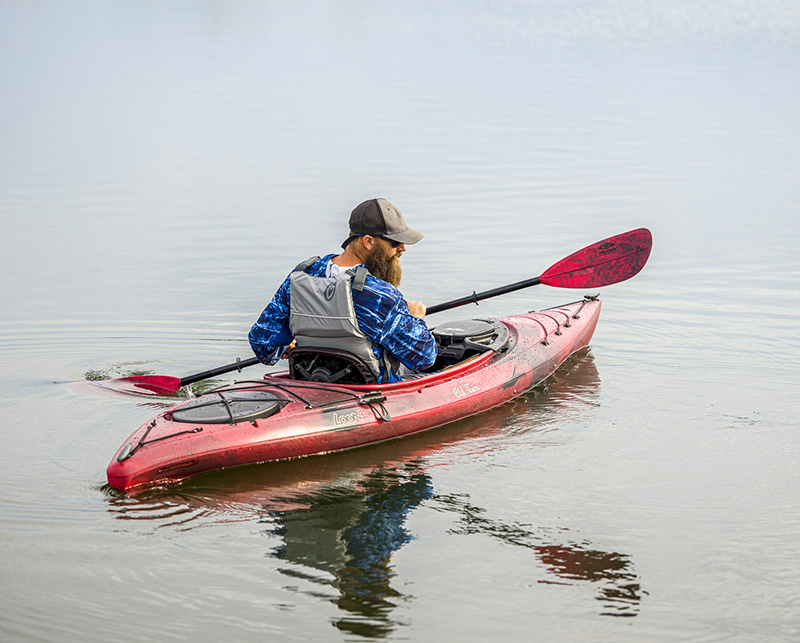
How to Choose a Kayak Paddle
You wouldn't play soccer in Air Jordans, right? Think of your paddle selection the same way. There are all kinds of kayaking disciplines that call for specific paddles, but we'll focus on the two most popular.
Recreation kayaks (including most fishing kayaks) tend to be very wide. They require a longer paddle with a broader reach, so you don't have to lean over the side to put a blade in the water. Recreation kayak paddles are good all-purpose options that are tough and dependable. Touring kayaks are also popular, and these long, narrow kayaks are made to cover lots of ground.
Touring kayak paddles are lighter for all-day use, and they have a specific blade shape that's designed for a more efficient, vertical paddle stroke.
Learn more about how to choose a kayak paddle and check out our selection of kayak paddles to find the paddle perfect for your next adventure on the water.
How to Choose a Paddle Length
Kayak paddle length primarily affects power. A longer paddle gives you more leverage, but it's like using a harder gear on a bicycle and it can quickly wear you out. As a general rule, paddlers between 5' and 5'10'' will want a paddle that's 220-230cm. Paddlers above 5'10'' should opt for paddles that are 230-240 cm, and very tall paddlers or those in kayaks wider than 30" might consider a paddle that's even longer.
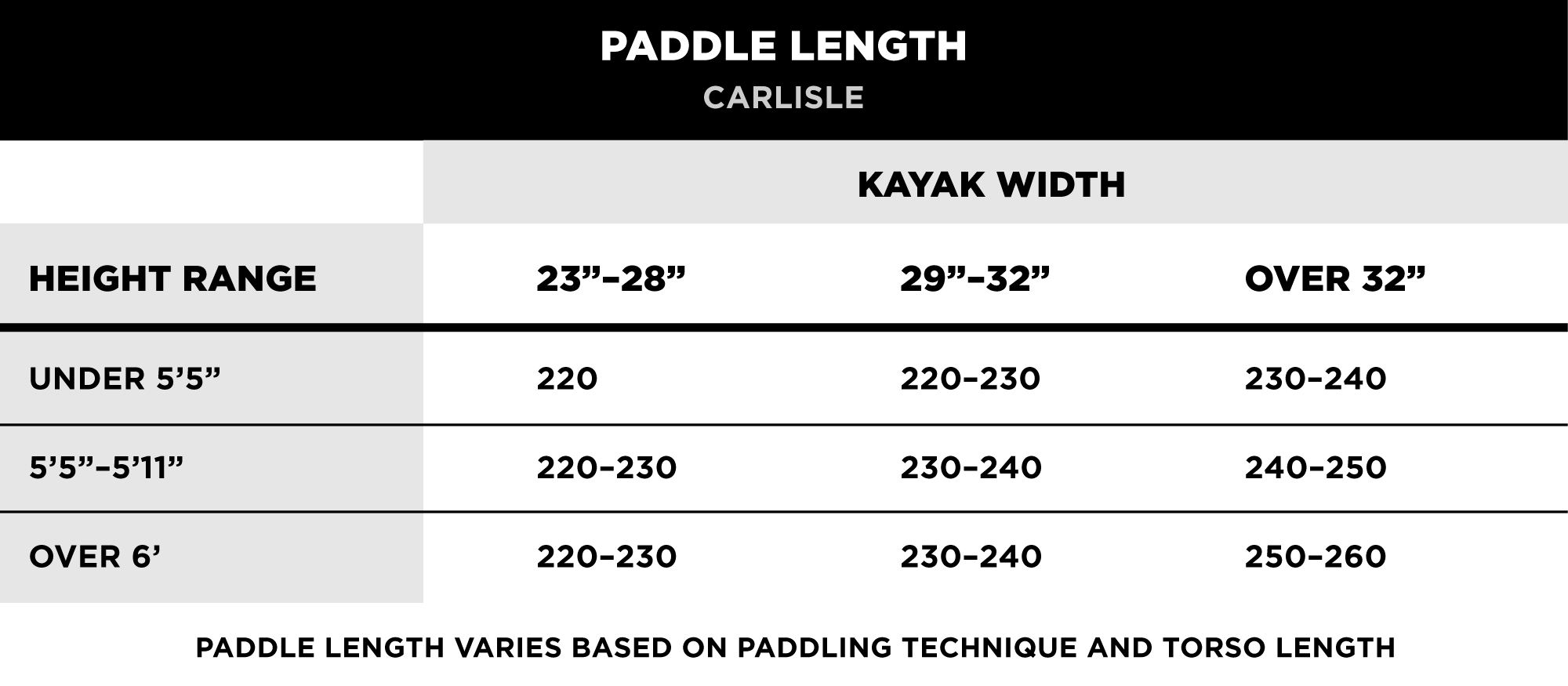
Kayak paddle length chart
How to Hold a Kayak Paddle
The best way to determine how to hold a kayak paddle is by putting the paddle on top of your head. With the paddle in this position, your elbows should be at 90-degree angles as pictured below. This technique ensures the proper hand spacing for comfort and power.
Basic and Fundamental Kayak Paddle Strokes
After doing your research and making your selection, it's time to learn how to use that new paddle!
Forward Stroke
The forward stroke is the most fundamental of three main kayak paddling techniques you'll want to master to become a proficient kayaker. To perform a proper forward stroke, put the paddle blade in the water near your toes and pull it along the side of the kayak, removing it when it reaches your hips.
Then repeat on the other side with the other blade. The closer your blades are to the side of the kayak, the straighter your kayak will travel through the water.
Don't get discouraged if you find it hard to paddle in a straight line right away. It takes practice!
Sweep Stroke
Because going straight depends on keeping your blade close to the side of your kayak, it makes sense that turning requires the opposite. You'll use the sweep stroke to turn.
Start by putting your paddle blade in at your toes and then draw a large "C" in the water until your paddle reaches the stern (back) of the boat.
When performing the sweep stroke, keep the arm on the stroke side as straight as possible. The farther away your blade is from your boat, the sharper the resulting turn.
Backward Stroke
The backward, or e reverse stroke, is the opposite of the forward stroke.
It's performed by putting the blade in at your hips and pushing it toward your toes. The backstroke is the least common of the three, but it's helpful for exploring an inlet that's too small to turn around in.
Kayak Strokes for Ocean and Near the Shore
The two key techniques we'll discuss for ocean paddling are how foot pedal adjustment can optimize vertical transfer and how to launch in surf.
The ocean presents unique challenges. The best paddling technique on the high seas eats up distance with smooth strokes, despite encountering swells and wind.
Ocean paddling, like canoeing or rowing, is much improved with proper vertical transfer, which involves full body motion, and especially core engagement, in each stroke.
Your foundation for optimizing vertical transfer lies in foot placement. Sea kayaks are built with adjustable foot pegs to brace the body and maintain an upright position, so that your legs also power your forward motion. In a sit-on top kayak, molded plastic foot wells also offer a place to brace feet against the boat.
Vertical transfer refers to the energy that moves from foot, lower leg, upper leg, and torso to the arms and upper body. This energy, which begins with braced feet placed on foot pegs or in foot wells, is transferred from lower body to upper body by engaging leg muscles and core (abdominal) muscles. The muscles engaged include those in the feet, legs, core, chest/back, and arms/shoulders.
From a distance, kayaking looks like an arms-only endeavor, but don't believe everything you see, as proper kayaking technique uses all major muscle groups.
On ocean waters, maintaining posture and body position is particularly important because the sea's constant undulation can tempt a paddler to slump or lose core engagement (similar to what can occur on a bicycle or motorcycle on a long ride).
While core engagement seems like "common sense," it is rarely how novice kayakers paddle. Whether you are learning how to paddle a sit-on-top kayak or a traditional sit-inside kayak, activating core muscles requires conscious effort, especially for those of us who aren't bounding to CrossFit class twice weekly. Kayaking can be great exercise activity.
You'll want a strong and durable paddle to use as you hit those ocean waters. The Carlisle Magic Plus is a great choice.
Before ever getting in the water, set your sea kayak's adjustable foot pegs. Position the foot pegs so your legs are slightly bent at the knee (as on a bicycle). As you adjust, remember you are making this decision to optimize vertical transfer and make the most of your fitness level.
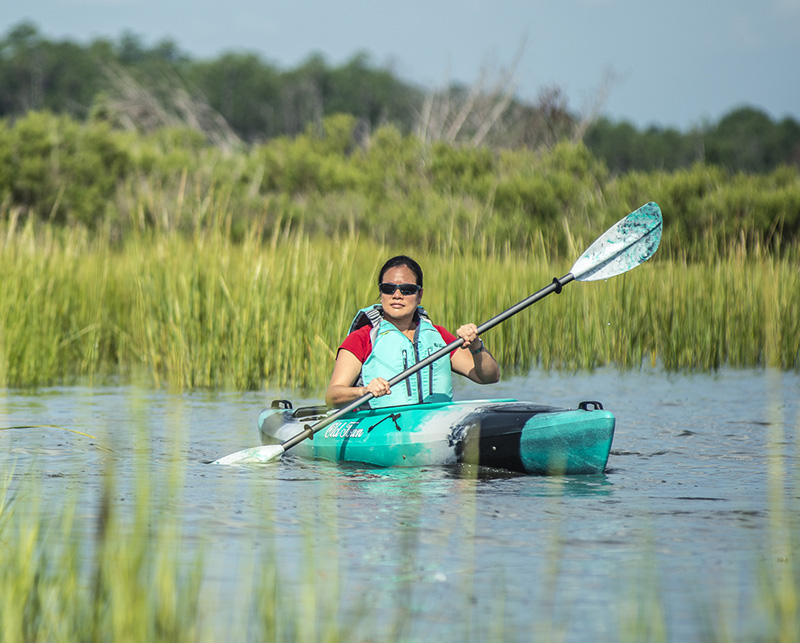
Ocean Kayak Paddling Hazards
The primary hazards on the ocean are wind and swells. Surf launching and returning to the beach also require a specific paddling technique.
In windy conditions and swells, maintaining proper paddling position can be challenging; kayakers are tempted to break stride and "reach" for the water as it disappears underneath them.
The best way to conserve energy on long voyages is to maintain form and create a steady rhythm. Consistent paddling preserves forward momentum and maintains the boat's position in a straight line.
Launching in a Kayak in Surf
To paddle like a pro when entering moderate (we don't recommend heavy) surf, focus on technique and don't be concerned about a spill. Always choose an area of the beach where there is as little slope as possible to minimize the surf's height.
Launch in the surf by getting the boat into two to three feet of water so you begin from a float position. As you approach the incoming wave, paddle with force and purpose as quickly as possible while maintaining an upright posture and keeping your kayak perpendicular to the wave.
Make sure you have one powerful downward/forward stroke as waves break over the kayak's bow. This power stroke reinforces forward momentum, while the paddle-in-water position stabilizes you to minimize chances of tipping.
All paddling when launching should be decisive, quick and confident. Much of the instruction on how to paddle into breaking surf is intuitive, but the key is assertively sprinting forward at the right time.
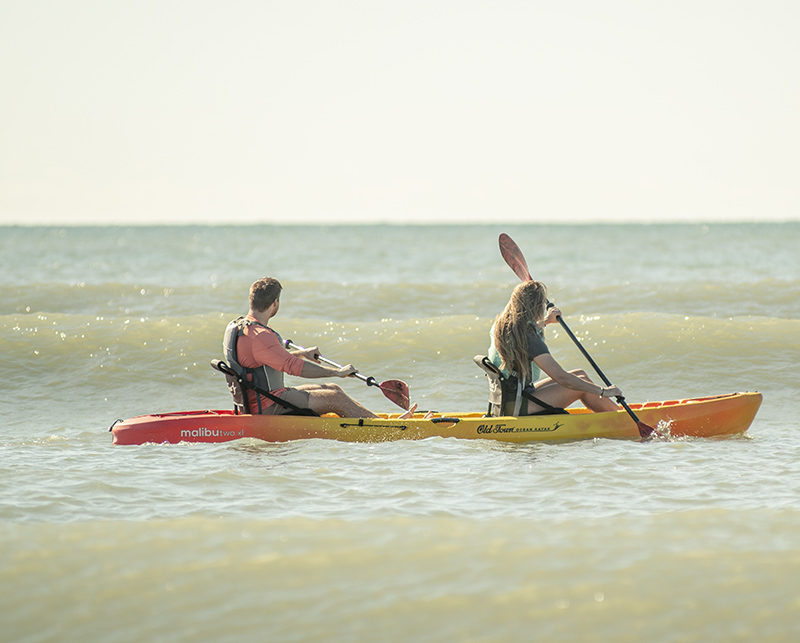
Kayak Strokes for Lakes (Still Water)
The key technique for lake paddling is sustaining momentum by using vertical transfer and correct posture while correctly using arms and upper body.
Lakes are the best place to practice a smooth forward stroke. Calm conditions allow you to test your technique without distraction as you can better estimate your speed. On a glassy surface, momentum is your friend and you have an opportunity to observe how straight your line is and how relaxed you are.
Lakes do not demand the same range of skills as ocean or river kayaking, but conditions can change without much warning whenever you are in open water so the ability to close distances is helpful.
Lake kayakers look as if they are dipping their blade in the water, then pulling it back toward the body. In fact, proper technique requires pushing the arm (from the shoulder, using a stable core) away from the body, while simultaneously pulling back with the opposite arm. The arm placed higher on the paddle pushes, the arm placed lower pulls. The emphasis should be on pushing with the upper paddle blade, from the shoulder, while pulling the lower blade into the body's core.
In practicing the push-pull technique, pay attention to the force originating from your shoulder.
Bicycling offers an analogy. When riding a bike with clip-in pedals, the majority of the force is the down stroke (pushing) while some energy gained on the upstroke (pulling the foot and leg back toward the body). Efficient cyclists turn pushing and pulling motion into a smooth revolution to get the most out of up and down strokes.
Push from shoulder, stabilize core, and keep full-body focus on vertical transfer with knees slightly bent and force of foot against the boat's recessed footrest or pedal. In kayaking, using legs, core and arms in coordination maximizes your body's power. If you're primarily a lake paddler, consider the Carlisle Magic Plus.
Lake Kayak Paddling Hazards
Lakes offer an illusion of safe, easy, trouble-free paddling. But predicting lake winds is tricky, even for experienced paddlers.
A steady use of your forward stroke paddling technique is essential to make forward progress if strong winds arise. In unrelenting headwinds, proper kayaking technique can mean the difference between reaching your car or staggering onto the nearest rocky beach, exhausted, for an unplanned night of camping.
Over distances, lake kayakers can generate a good rhythm with the right form-getting into a groove that makes paddling meditation-like, even if conditions aren't ideal.
Kayak Strokes for Rivers (Moving Water)
The key techniques for river paddling relate to maneuverability, which starts with the versatile draw stroke for a controlled turn. Combining forward, draw and reverse strokes will give you confidence to handle 90% of what rivers throw at you, before you tackle the bigger waves beyond class I and II rapids.
River kayaking requires more paddling experience and practice because of the range of skills involved. By the same token, running rivers will allow you to accelerate your paddling ability.
Extended river trips are likely to expose kayakers to every hazard imaginable, including hidden currents and sunken obstacles. In the current, you are more likely to need to reverse, spin around quickly, steer, and slow yourself down. You are far more likely to come across an unexpected obstacle that requires sudden adjustment than you would during an ocean or lake outing.
Because river conditions are constantly changing, we recommend learning how to make a controlled turn and stop or reverse your kayak. A combination of forward, reverse, and draw strokes will allow you to reach shore as swiftly as possible, steer, or cross the river if an intriguing fork presents itself.
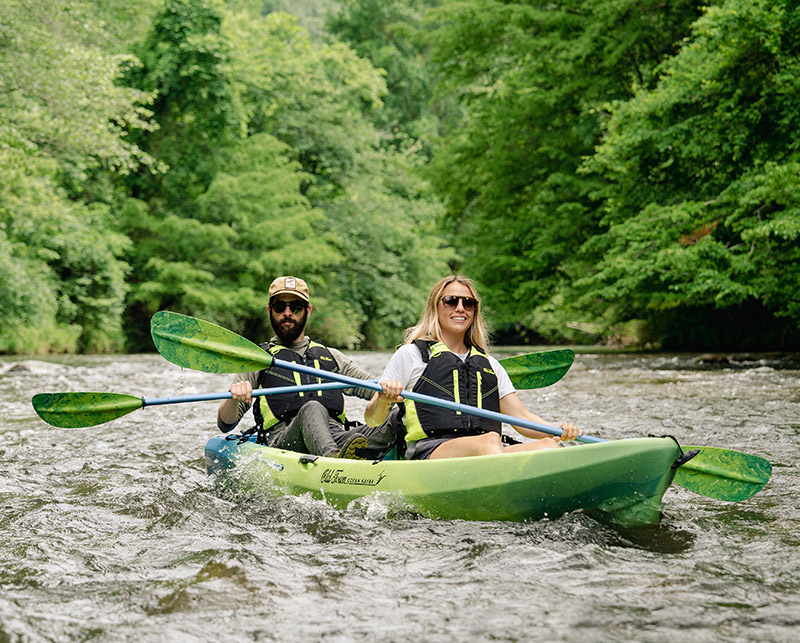
For more informative articles about kayaking tips and techniques be sure to check out our kayaking tips blog.






